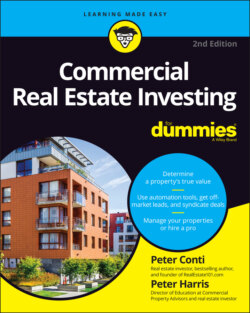Читать книгу Commercial Real Estate Investing For Dummies - Peter Harris - Страница 47
Talking the Talk: Terms You Need to Know
ОглавлениеThroughout this chapter, we use some terminology that you need to be familiar with. Having these terms under your belt is crucial on two fronts:
We presume you’re reading this book because you want to invest in commercial real estate. Most likely, you’ll be using a real estate broker to help you locate and close the deal. Real estate brokers know — and use — most of the terms mentioned here. Gaining a thorough understanding of the terms levels the playing field. If you can speak their language, you gain instant credibility and a relationship advantage over someone without your knowledge and understanding.
Just by increasing your word power, you gain increased confidence, which enables you to make sound, efficient investment decisions, and gives you an increased ability to hold your position, especially in negotiations.
Here are the words you need to know to navigate this chapter and talk the talk:
Capitalization rate: Your capitalization rate is your net operating income divided by the sales price. Also known as the cap rate, it’s the measure of profitability of an investment. Cap rates tell you how much you’d make on an investment if you paid all cash for it; financing and taxation aren’t included:Cap rate = net operating income ÷ sales price
Cash flow: Your annual cash flow is net operating income minus debt service. You also can figure monthly cash flow by dividing your annual cash flow by 12:Annual cash flow = net operating income – debt serviceMonthly cash flow = annual cash flow ÷ 12
Cash-on-cash return: To find your cash-on-cash return, divide your annual cash flow by the down payment amount:Cash-on-cash return = annual cash flow ÷ down payment
Debt service: Debt service is calculated by multiplying your monthly mortgage amount by 12 months:Debt service = monthly mortgage amount × 12
Effective gross income: You can find your effective gross income by subtracting vacancy from gross income:Effective gross income = income – (vacancy rate % × income)
Gross income: Gross income is all of your income, including rents, laundry, or vending machine income, and late fees. It can be monthly or annual.
Net operating income (NOI): Your net operating income is your effective gross income minus operating expenses:Net operating income = effective gross income – operating expenses
Mix: When a commercial investor says “What’s the mix?,” they’re asking how many studios, one-bedroom, or two-bedroom units the property has.
Operating expenses: Your annual operating expenses for the property typically include taxes, insurance, utilities, management fees, payroll, landscaping, maintenance, supplies, and repairs. This category doesn’t include mortgage payments or interest expense.
Vacancy: A vacancy is any unit that’s left unoccupied and isn’t producing income. Remember: A unit that’s vacated and re-rented in the same month isn’t considered a vacancy; it’s considered a turnover.
Vacancy rate: Your vacancy rate is the number of vacancies divided by the number of units:Vacancy rate = number of vacancies ÷ number of units
